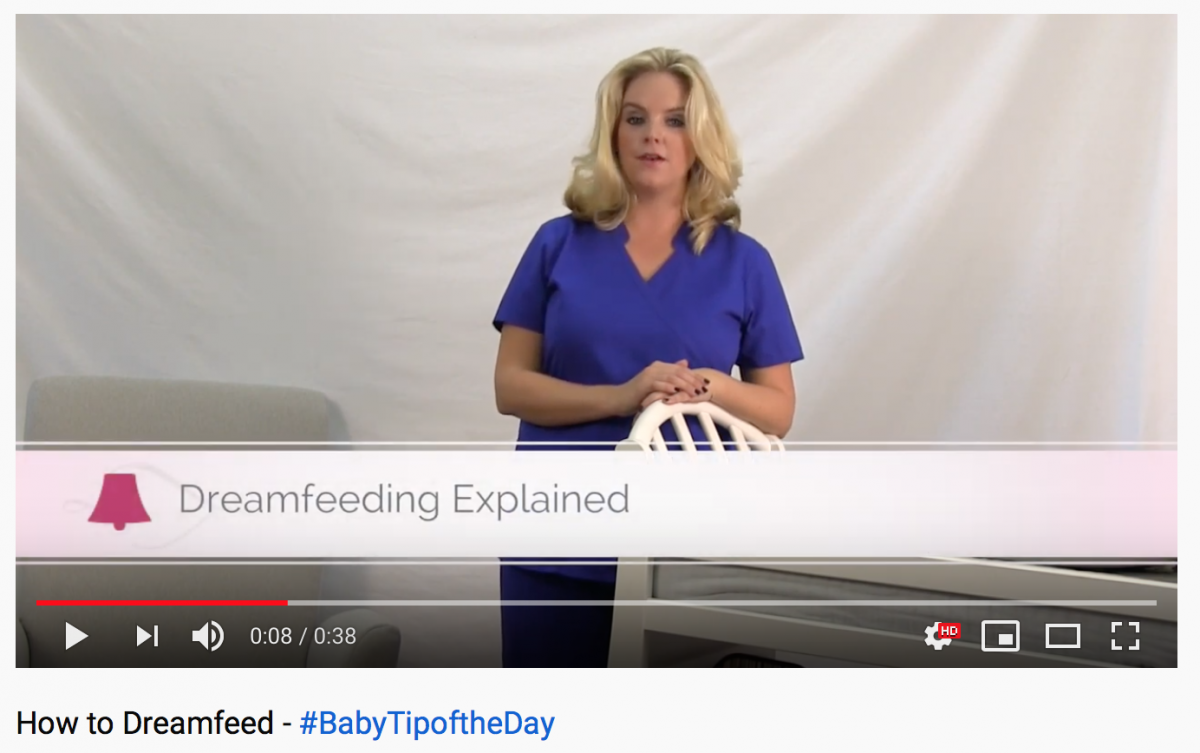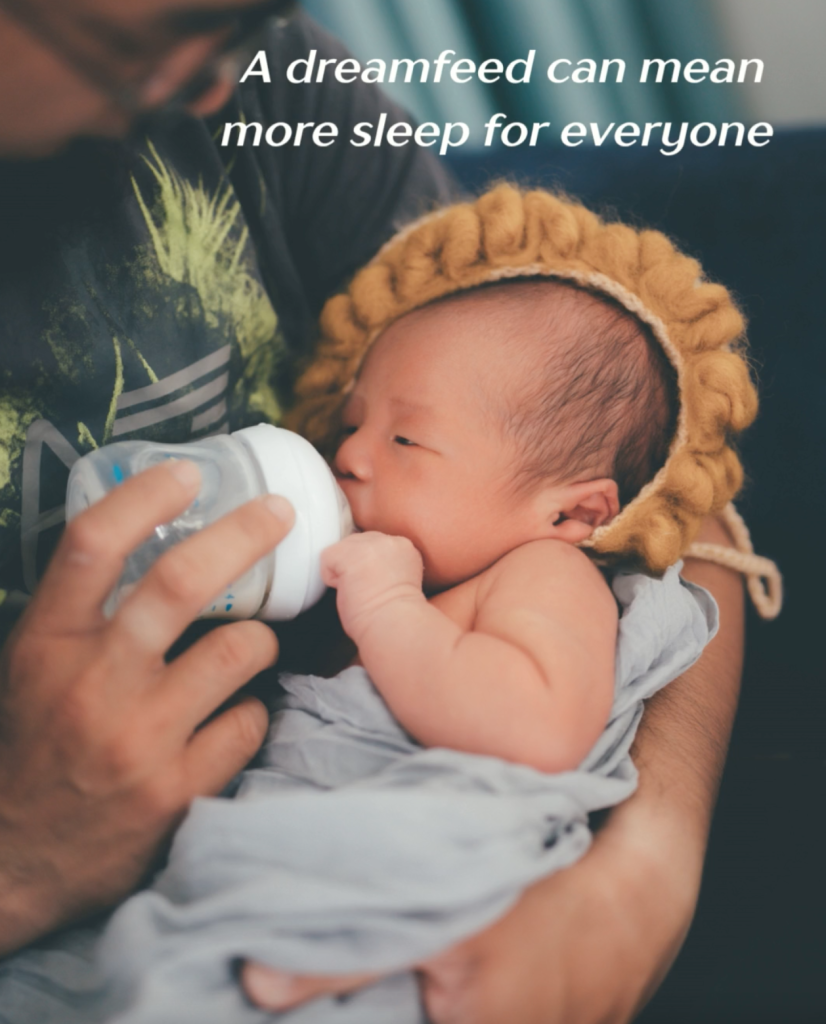What is a Dreamfeed?
updated September 29, 2023 – When seeking ways to help baby sleep longer stretches at night, parents commonly hear advice that they must offer baby a “dreamfeed.” But what is a Dreamfeed? And how does it work? Here’s how this scheduled feeding technique works:
What is a Dreamfeed: Key Takeaways
- A dreamfeed is a feeding you give your newborn between 10–11 PM while they’re still drowsy or asleep.
- Helps align your baby’s longer stretches of sleep with your bedtime, giving both of you more rest.
- Minimizes surprise middle of the night wake ups because your baby is fed and satisfied after the dreamfeed.
- The technique doesn’t guarantee longer stretches every night, but it can be a helpful tool for families trying to foster longer, more consolidated sleep.
What is a Dreamfeed? A feed between 10pm-11pm
Popularized by the widely respected Baby Whisperer newborn care books, to dreamfeed means to simply bring breast or bottle to baby’s lips in the later evening hour. This is usually around 10pm-11pm when baby is still asleep. Why 10-11?
- This timing allows the baby to receive nourishment that sustains them for a few hours and potentially reduce the frequency of nighttime awakenings.
- If your typical time going to bed is 10pm, you have some assurance that you’ll get a decent block of sleep before the next wake up.
- If your baby last ate at 7pm, 10-11 would be the next timeframe in which they are typically hungry so you are getting to them before they fully wake up, making getting them “back down” easier.
In other words, because your baby is full and comfortable in the 10pm hour, they’ll sleep longer while you’re sleeping.
Your infant will instinctually take in what their little body needs at that time, usually just a few ounces. Postpartum doula’s know this technique works because there is also no reason to burp or wake since they will be relaxed enough to go back to sleep after the feed.
In other words, feeding baby before you go to sleep means that you might eliminate one of the middle-of-the-night feeds. You know you’re going to get up anyway to feed your newborn so why not take the guesswork out of it and help both of you sleep for a long stretch.
You can do quick diaper change after the feed too just to be sure your infant is comfortable and clean!
Tip from the Night Nurses: Folks like to say that wipe warmers are a waste of money but we disagree!
That cold wipe during a dreamfeed diaper change can startle your newborn or infant! Invest the 15 bucks to make sure those wipes are warm and soothing…keeping your baby in a sleepy state of mind overnight!

Why Does A Dreamfeed Work?
Without a dreamfeed, a baby who typically feeds in the 7 PM hour may awakens naturally from hunger at midnight, 1 AM or 2 AM. Giving a feed in the 10:00 hour allows parents to head off this hunger and may allow baby to sleep longer, usually until 4 AM. By giving a feed at 10 PM, instead of waiting to see when baby naturally wakes to feed, we are shifting baby’s asleep hours to match parents, so parents get a long stretch of sleep themselves.
The addition of these few extra ounces will eliminate the physical need for baby to awaken for the first overnight feed. This is because we’re taking waking from true hunger out of the equation. As your infant gets older and able to physically sleep 10-12 hours without needing to eat (which is only decided on by families and their pediatrician) the dreamfeed provides that final feed of the night to take babies through to their natural wake up time in the morning.
How a typical dreamfeed schedule works:
6:30 or 7:00 PM: Baby’s last feed before baby’s bedtime
10:00 PM: bring bottle/breast to baby while baby is still asleep (dreamfeed)…this is before your bedtime
10:20 PM: quick diaper change and back to sleep
While certainly not a necessity, the dreamfeed is a simple extension of baby’s natural 3 hour feeding cycle. It works whether parents are breastfeeding or formula feeding.

What is a Dreamfeed? – Sleeping through the Night
If you want to pave the way for long, independent stretches of sleep overnight, Let Mommy Sleep night nannnies and doulas recommend a dreamfeed. In addition to helping parents sleep well, another benefit of dreamfeeding is gently weaning the amount of milk or formula that is taken in during the overnight hours. Because your infant is consuming exactly the amount their body wants in such a relaxed state, you’ll see that they naturally take in less and less.
If you would like more information on baby sleeping through the night, these step-by-step instructions may help.
What is a Dreamfeed? – Are there any Downsides?
A dreamfeed is a safe and useful tool to keep in your baby sleep toolbelt but be aware that there are few potential downsides.
- Dreamfeeding could potentially be challenging if you’re breastfeeding because your nursing relationship is built on supply and demand. Skipping or adjusting nighttime feedings might mean that your supply needs a few days to catch up to the new dreamfeed time of 10pm, if you’ve never done feeds at that time before.
- We Woke a Sleeping Baby!: If your baby was in a spot where they are waking up anyway at 10pm, they might actually fully wake up during the feeding. So while you might have been prepared for a 10-15 minute dreamfeed session, you’re baby might now be wide awake. You would have been doing this 45 minutes of feeding anyway but it’s good to know that the dreamfeed might not be perfect every time.
Categories
- Corporate Care & Partners
- COVID19 Archive
- En Espanol
- Expert Guides
- Hiring a Night Nanny
- Infant Safety
- Infant Sleep Hub
- Newborn Care
- Postpartum Health
- Twins & Multiples
- Work as a Night Doula
- zPost Archives
